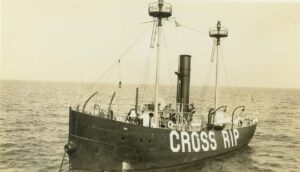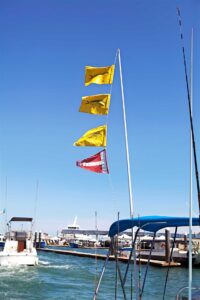On a sunny afternoon in May 1915, a German submarine off the coast of Kinsale, Ireland, unleashed a torpedo that exploded on the starboard side of the RMS Lusitania. In 18 minutes, the luxury ocean liner sank to the bottom of the sea, taking 1,198 passengers and crew, including 128 Americans, to a cold, watery grave. RMS Lusitania was not the first or the last vessel destroyed by German U-Boats during World War I, but this maritime tragedy helped set the wheels in motion for America to step up its Naval presence in Europe. The Atlantic seas were teeming with the Kaiser’s predatory submarines that ruthlessly targeted civilian and military vessels, especially those carrying supplies across the ocean. In 1917, America officially joined the war, and President Woodrow Wilson devised a grand plan to counter the Germany submarines’ nautical dominance. Wilson wanted transport ships. Lots of them. So, he gave the green light to the greatest shipbuilding initiative in American history — a $1 billion program to construct 1,000 steamboats in 18 months in shipyards across the country. Now, here’s where the story starts to get funky. You can’t blame Wilson for not owning an Ouija board to tell him that Germany would surrender in 1918. The 1917 intelligence suggested that America was in the Great War for the long haul, and Wilson hoped to flood the Atlantic with enough boats to regain control of the seas. Instead, he ended up flooding the Potomac River with hundreds of ships, and that’s why the rest of this tawdry tale belongs to the Chesapeake Bay.
The Best Laid Plans Fall Asunder
To meet the ambitious goal of 1,000 ships, builders tried to save time and money on construction. Hulls were built of wood, which was cheaper than steel but not as durable. Their hasty workmanship was subpar; boats were poorly caulked and quite leaky. The project ran way behind schedule, and by 1918 only 130 vessels were ready to roll and 260 were only half finished. To make matters worse, the invention of the diesel engine made these coal-burning steamboats obsolete.
By the time the war was over, Uncle Sam had no use for the fleet of misfits. Government administrators gathered most of the ships and docked them on the James River in Virginia. Congress attempted to sell them to Uruguay but had no luck. In 1922, Western Marine & Salvage Co. (WMSC) bought the entire flotilla for a song at auction and towed them to Widewater, Va., for scrapping.
WMSC’s plans to burn the ships and submerge their remains in local marshlands were met with fierce resistance from watermen and nature activists. In 1924, WMSC bought 566 acres of land in Mallows Bay, about 40 miles south of Washington, D.C., on the Maryland side of the Potomac River. About 214 ships were moved to their final resting place in Mallows Bay. Even this part of the story goes poorly. When a large group of boats were torched, frantic rats raced ashore and enraged local residents. Then WMSC filed for bankruptcy in 1925 and abandoned the unwanted armada.
For decades the ships languished, neglected but not completely ignored. During the Great Depression, scores of unemployed men found work by scavenging the wreckage for scrap metal, and the dry days of Prohibition inspired resourceful bootleggers to erect moonshine stills on top of the rubble. To top it off, houseboat brothels dropped anchor nearby with ladies hoping to share nocturnal pleasure on the river.
In the 1940s, Bethlehem Steel tried to recover iron and scrap metal from Mallows Bay for World War II efforts, but this endeavor also failed. What locals call the Ghost Fleet of Mallows Bay was left to rot until 1993 when the State of Maryland decided to study the boat cemetery. Its inventory revealed a remarkable historic treasure trove — the remains of 88 World War I steamships, 12 barges, a Revolutionary War longboat, several 18th-century schooners, workboats and car ferries such as the SS Accomac. It seems centuries of dumping had turned Mallows Bay into an archaeological recycling bin.
Step Aside Humans. Nature’s in Charge Now
Fortunately this odd saga has a happy ending. Over the past 50 years, flora and fauna have taken over Mallows Bay, bringing new life to the ill-fated fleet. Ospreys build nests in the rusty portals, tall trees sprout from the hulls, bass flourish in the waters and eagles soar overhead. It’s become a hidden destination for historians with kayaks or canoes who love to float among and examine vessels from a bygone era.
The Maryland Park Service now maintains Mallows Bay and has built a boat ramp for small watercraft and a hiking trail for visitors to explore the site by land. The area is en route to becoming a National Marine Sanctuary. If you want to get a close look at Mallows Bay and its historic ships, go to 1440 Wilson Landing Road in Nanjemoy, Md. Navigating through the ships by kayak or canoe is strongly recommended.




